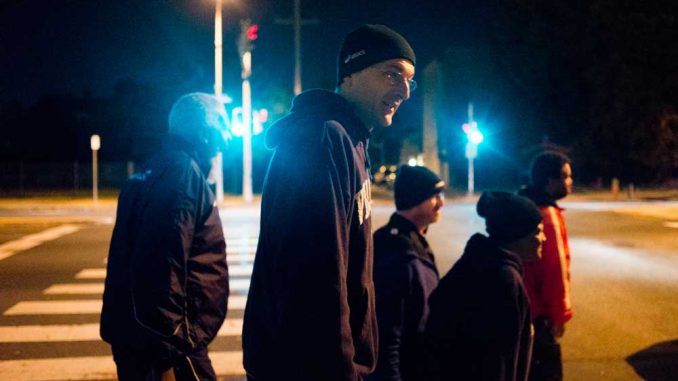
More than 100 people gather for a jog before sunrise on a street corner in Center City. Half of them are homeless.
The run is part of Back on My Feet, a national organization with the goal of creating self-sufficiency among those experiencing homelessness. The catch is that those seeking advice, resources and shelter must show up to run three days a week or for at least 90 percent of the runs.
Founder Anne Mahlum and those involved with Back on My Feet said they believe a commitment to running and in turn good health, leads to self-discipline and a more structured life.
“Our members work hard for every benefit they receive,” Megan Keen, a Back on My Feet intern and Temple junior said.
To join, residential members must sign a dedication contract after living in a partner shelter for 30 days. After running a certain amount of miles, members join the Next Steps program through which Back on My Feet offers financial literacy programs, résumé-building and other tools necessary to obtain a job, such as a suit or subway tokens to get to an interview.
Approximately 70 percent of residential members are in the Next Steps phase of the program. Since the start of the first branch of Back on My Feet in 2007, Philadelphia alone has had 205 residential members obtain employment and 143 members have their own housing. The organization is located in 11 other cities in the U.S.
Back on My Feet has a large team of non-residential members that dedicate time to attending and organizing runs. One residential member, Robin Dawson, said she drew inspiration from volunteers when she decided to join Back on My Feet.
“I saw them and thought, ‘If these organizers and members can invest so much of their time and energy, I can invest mine and give this a shot,’” Dawson said.
Despite having arthritis, asthma and other health issues, Dawson joined Back on My Feet in July 2013 after seeing members returning from a run.
“They had such a different and positive energy compared to everyone else in the shelter,” Dawson said.
Dawson used to start work at 7 a.m. during the week at a Norristown State Hospital. After she experienced homelessness, Back on My Feet helped her return to a strict schedule while training for and running a 5K race in the process.
“I became addicted to running because it motivated me to frame my entire day from that point,” Dawson said. “My mind was clear, and no one viewed me as a charity case.”
Back on My Feet Program Director Evan Cantiello said a sense of confidence is necessary to self-sufficiency, and that is why the organization holds such high expectations.
“Suddenly people see what they can do and realize they’re capable of something they never knew was possible for them,” he said.
Cantiello has seen many residents reconnect with family and loved ones through the showcasing of their achievements, mainly through pictures displayed on the organization’s website and Facebook page. He said he believes these athletic achievements further boost confidence and autonomy.
“Running is an overarching structure that exists in someone’s life,” Cantiello said. “They learn to recognize things that keep them from excelling, such as a bad diet or sleeping schedule.”
Unfortunately, those suffering from physical or mental disabilities are unlikely to become involved with Back on My Feet. The dropoff rate of those who self-select out of the program is around 20 to 25 percent.
“Running is not universal for everyone,” Cantiello said. “We’re trying to figure out the safest way to integrate those who can’t run and our doors are always open to those who give up and want to come back.”
However, Back on My Feet has seen great progress in those who are able to run. Cantiella said one member in Washington named Walter recently competed in a Leadman race — a race that requires participants to run 100 miles.
Back on My Feet frequently participates in races and holds fundraisers. Alongside National Hunger and Homelessness Awareness Week from Nov. 18-22, the organization will hold a fundraiser called Sneaker Week.
For this event, Back on My Feet pairs with hundreds of companies, offices and universities that invite their employees to donate $5 or $10 to the organization and wear sneakers and jeans to work. Donors will receive a branded item.
“For some organizations, wearing sneakers to work is no big deal,” Scott Crossin, the executive director of Back on My Feet, said. “We strive to make fundraising relevant for those companies too, by figuring out different strategies that are relevant to them.”
Companies participating can set fundraising goals. Back on My Feet will provide them with a link to a fundraising page that allows them to promote their campaign and involvement.
Back on My Feet will also hold “fundracing” for the 2013 Philadelphia Marathon. Runners can gain entry to the marathon and sold-out half marathon through this fundraising event if they commit to raising a set amount of money for Back on My Feet. Participants will receive a set of performance clothes.
“This is a really important relevance driver for our organization,” Crossin said. “It allows people to do something they aspire to do while making a tangible difference for others.”
Claire Sasko can be reached at claire.sasko@temple.edu.



Be the first to comment